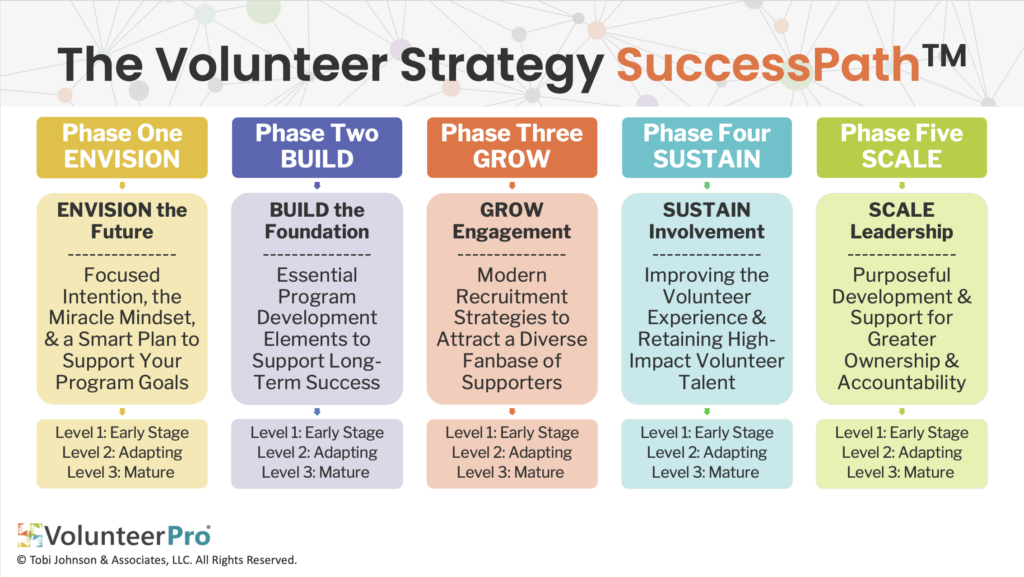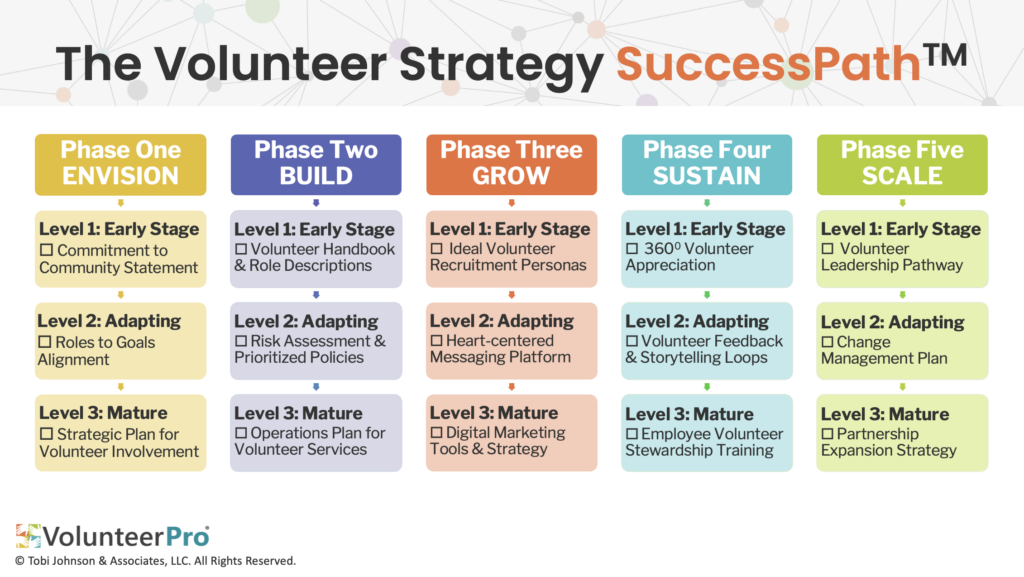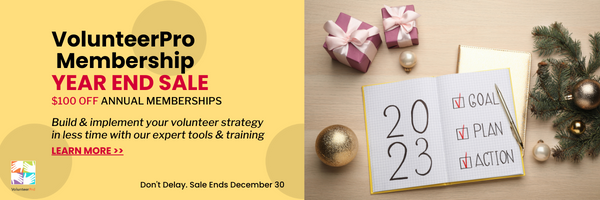Strategic Volunteer Engagement – Our Recommended Pathway to Success
Strategic volunteer engagement is a buzzword that has been used lately to describe next generation volunteer involvement. But what does “strategic:” really mean? And what is required to achieve it?
Last week, we led our very first strategic planning workshop, VisionWeek, specifically for strategic planning related to volunteer involvement. Over the course of five days, we guided participants through our three-step planning framework: READY – Envision a Bold Future, SET – Plan Your Strategy, GO – Implement Your Strategy.
Through our interactions with participants throughout this action-packed week, we learned a lot about the state of planning for strategic volunteer engagement and where there are still barriers to achieving it.
VisionWeek was designed to help volunteer-involving organizations move from tactical to strategic in their thinking. In my consulting, coaching, and training work with nonprofits, I have found that “strategic planning” most often looks like a brainstorming meeting or a debate about which tasks should be attempted in the coming year(s), with less deep thinking about the context of the work and how the organization’s response must be tailored to it.
For more on the differences, check out Volunteer Engagement Strategy Versus Tactics for 2023 HERE>>
Priority #1: Aligning Work Across the Organization
When organizations plan for the future, we find they often focus more on tactics and less on the strategy that should drive both the selection and implementation of those tactics to reach goals. They often give the volunteer manager a directive – “find more volunteers” or “diversify the volunteer base” with little thought about how this might relate to the organization itself or the community as a whole.
One of the first steps toward strategic volunteer engagement is to directly align the work of volunteer services with the main goals of the organization. There are many reasons for this, and here are a few we mentioned during VisionWeek. Strategic alignment …
- Clarifies the link between volunteers and the agency’s bottom line
- Positions volunteer talent as a strategic resource
- Helps grant writers generate quality funding requests in less time
- Helps leaders of volunteers make a stronger case for internal support
- Helps prioritize work and provide justification for projects you take on (or don’t)
- Ensures the right people are invited to meetings that matter
- Helps everyone build their leadership skills and influence at all levels
During VisionWeek, we recommended that participants review their organization’s strategic plans. However, we found that many had difficulty quickly getting their hands on their organization’s plan or even obtaining a list of strategic goals for the organization in the coming year. Instead, they needed to set out and find this information.
The mere fact that volunteer services are not already aligned or made aware of the organization’s larger goals indicates that silos not only exist, but also that the organization’s leadership does not understand the function of volunteer services as a strategy directly related to their goals.
Fundraising, DEIJ initiatives, program development, staff retention, community engagement, sustainability, impact…these are only a few aspirations for nonprofits that commonly find their way into nonprofit strategy plans. And there are myriad ways that strategic volunteer engagement might support progress around these goals.
So, it makes sense for organizational leadership to plan with volunteers in mind, and share their strategic goals with leaders of volunteers so they can take steps to align the work of volunteers to support these goals. When it is clear how volunteer talent can be directly deployed in service of the organization’s goals – and everyone understands these alignments – teams can row together (and grow together) as they reach their goals more quickly than by working in independent silos.
For more on how to improve this planning process, check out How to Build a Strategic Volunteer Engagement Plan (and Why You Should!) HERE>>
Strategic Volunteer Engagement: Helpful Ingredients for the Process
As organizations consider how to improve their volunteer engagement strategy, the following kinds of resources can be instrumental to the process:
- Standards for Volunteer Involvement
Programmatic standards help volunteer-involving organizations check their own practices against broadly agreed-upon best practices in the field of volunteer involvement, regardless of cause type, location, or size of the organization. The Australian National Standards for Volunteer Involvement and the Canadian Code for Volunteer Involvement are two sets of high-quality standards that were developed through a vigorous process of research and stakeholder input to develop checklists for quality. In addition, Investing in Volunteers (IiV) is the quality standard developed in the United Kingdom for best practices in volunteer management. Regardless of where you live, all three sets of standards are exceptional resources and can be widely applied to volunteer-involving organizations around the world. They can help organizations objectively pinpoint gaps they may need to shore up and include them in their implementation and resourcing plans. - Volunteer Management Competencies
Unlike standards for volunteer involvement applied to organizations or volunteer programs, competencies relate to individual staff members. These sets of knowledge, skills, and abilities relate directly to the leaders of volunteers and others in the organization who handle volunteer engagement and supervision. The Council for Certification in Volunteer Involvement (CCVA) maintains a Body of Knowledge and Competency Framework that serves as the foundation for the Certified in Volunteer Administration (CVAQ) credentialing process. This list of competencies was developed by a peer task force in partnership with a psychometrician and feedback from the field. The CCVA periodically updates these competencies to ensure they are in line with evolving practices. Frameworks like these also offer organizational leaders a fresh perspective on the many roles that volunteer managers play. They can also help them focus their hiring and selection of high-quality candidates who are able to successfully build a plan for strategic volunteer engagement at their organization.
Ready to hire your next volunteer manager? Check out Volunteer Nation Podcast Episode #026: Hiring? What to Include in Your Volunteer Coordinator Job Description HERE>>
Also, download our Free Guide: How to Hire a Kick-A** Volunteer Program Manager HERE >>
- Volunteer Program Assessment
Equipped with both Standards for Volunteer Involvement and Volunteer Management Competencies, organizations can take steps to evaluate their current volunteer engagement strategy and programming against established practices. Organizations can, and do, self-assess their current state and even their progress toward their desired future state. However, they run the risk of biased and inaccurate results. Staff may overestimate or overrate their work or the performance of their volunteer strategy as higher than average. Alternatively, they may underrate their progress. In both cases, staff are unable to perceive their ability or their program’s performance precisely, making it difficult to develop a strategic plan that starts with an accurate foundation. Consultants, too, have blind spots in their own assessments of volunteer programs. They often have only their own experiences and a set of standards to rely on. It takes a skilled assessment professional to question their own assumptions in a diligent search for perspectives beyond the most obvious to help ensure the organization’s investment expense is worth it.
While standards, competencies, and consultants can help your organization get a handle on where they are now and where they hope to be, these do not replace the work that needs to be done to get there. This is where standards, assessment, and action combined can make a difference.
Strategic Volunteer Engagement: Get There Faster with a Volunteer Strategy Success Path
A success path is a visual representation of the transformational journey an individual or organization will take to move from their current state to their future desired state. Unlike standards and competencies, which offer lists of benchmarks to assess against and set a path to attain, a success path is focused on action and implementation.
Success paths focus on phases of implementation and are often accompanied by milestones and action items that show the way forward. The goal of this framework is to simplify growth by focusing on the significant few steps that drive progress, rather than the “trivial many” that eat up time and keep us stuck.
Overwhelm is one of the primary reasons nonprofit staff don’t take bold steps to improve their volunteer strategy. They don’t have clarity on which actions to take, so they take none. But it is by taking action that we generate clarity. So, it’s essential that organizations get moving, even when they are not entirely sure of the outcome. The success path is a curated succession of steps and actions that, when followed, makes success infinitely more attainable.
The VolunteerPro Volunteer Strategy Success Path™
The VolunteerPro Volunteer Strategy Success Path™ is the foundation of our teaching and includes the essential elements for successful volunteer engagement, based on decades of research and direct experience in the field.
It combines standards with actions and deliverables that can help organizations get traction quickly and is the backbone of both our Volunteer Management Fundamentals Certificate online course and our VolunteerPro Membership Community.
In addition, the VolunteerPro Volunteer Strategy Success Path™ includes action steps in three different levels for each phase – Early Stage, Adapting, and Mature. Because strategic volunteer engagement is a complex, multi-faceted undertaking, we wanted to offer our students and members the ability to pinpoint where they were in their evolution with much more accuracy than a monolithic program assessment.
The image above is an abridged version of our entire Volunteer Strategy Success Path™TM. It includes key deliverables that must be in place to advance to the next level of strategic volunteer involvement. Practitioners can assess their levels and choose which phase makes the most sense to focus on, based on their current organizational priorities.
What makes our Success Path framework different than lists of helpful program standards and competencies is that, in addition to a list of deliverables, it offers a recommended roadmap to get there. The focus is on creating clarity, building momentum, and evolving the strategy through implementation.
It has a bias toward action versus self-reflection. And given the pressure organizations and staff are under to do more with less, we feel that it’s the best way to keep moving forward toward realizing your biggest dreams for your organization and the community you serve.
Ready to Implement Your Plan for Strategic Volunteer Engagement? Get Started Now!
When it comes to volunteer engagement, what could you accomplish in 2023 if you had a clear roadmap for success?
What would it mean for your organization if you had an army of enthusiastic volunteers supporting your mission every step of the way?
How would it feel to have MORE time and LESS stress as you build out a strategy designed to get results?
You won’t know until you take the first step.
Become a VolunteerPro Member and get ready for exponential volunteer growth in 2023.
Gain immediate access to an expansive library of easy-to-use templates and tools, live training, and focused coaching all aligned with a focused pathway designed to get your organization to the finish line faster.
There is intense competition out there for dedicated volunteer talent, but that doesn’t need to stop you. 2023 can be your organization’s best year yet. A VolunteerPro Membership can help you get there.
Get $100 OFF Memberships until December 30
Don’t delay. Prices go back up in 2023.









